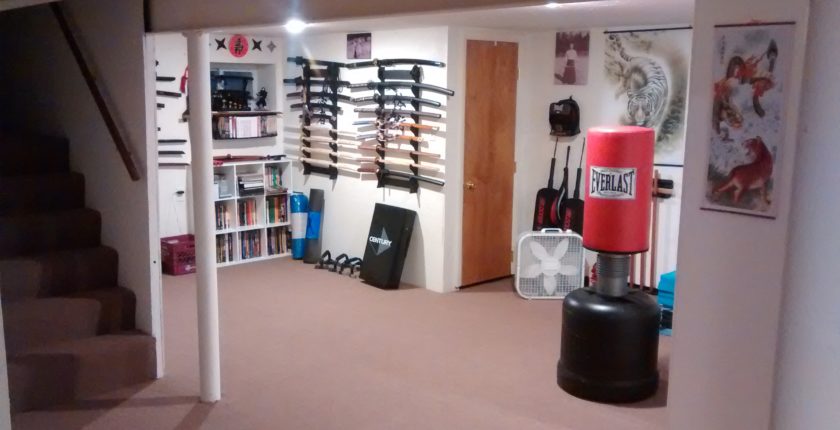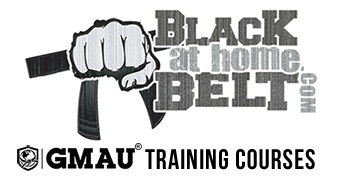Black Belt at Home Blog
How to Set Up the Best Home Dojo
- May 20, 2020
- Posted by: GMAU
- Category: Home Study Students

Sometimes life happens and you can’t make it to the dojo. When that happens, you might find yourself wishing you had a dojo at home. Good news: due to the wide range of products available online, it’s easier than ever to set up your very own home dojo.
You don’t have to construct an entire building to set up a dojo, just a few personal touches and pieces of equipment can be sufficient.
How to Set Up a Home Dojo
Training for martial arts at home isn’t the same as training for general health and wellness at home. Depending on the martial art you practice, you’ll need to consider space and equipment needed for footwork, grappling, strength building, flexibility, and cardio, just to name a few.
Before you start buying equipment for your dojo, think about the logistics so you don’t get carried away:
- How big will your dojo be?
- How much money can you afford to spend creating it?
- What will you use your dojo for?
- At minimum, what do you need to have a successful training session at home? You might find that you only need a small amount of space and some basic equipment in order to get started. Don’t wait until you have every single piece of equipment on your wish-list before you consider your home dojo ready to use.
You want to set up your dojo in an area where you can practice undisturbed. A basement or lower-level room works great. You could also use your garage, outbuilding, or spare room. If you’re really short on space, you can corner off a section of your living room or bedroom. Your backyard or any green space can work, too.
Consider the flooring you’ll be practicing on. Concrete or tile flooring can be too hard depending on what type of exercise you’ll be doing. You may want to invest in foam flooring or consider doing high-impact exercises outside on grass or softer ground.
Rubber flooring, foam flooring, artificial grass, and carpet are just some of the flooring options available for your home dojo. Here’s a comprehensive guide on home gym flooring that helps you understand the pros and cons of the different flooring options on the market.
Also, think about how much equipment you can realistically fit into your dojo. If you only have a small room, you’ll want to get creative with storage ideas for your equipment. If you need inspiration on potential home dojo layouts, here are some examples of organized home gyms.
Equipment to Include in Your Home Dojo
Think about your most-used martial arts equipment that you use at your regular dojo and start there. Breaking boards, agility ladders, tatami, training weapons, and hula hoops are all pieces of specialized gear that should be included only if you use them. There’s no sense in paying for equipment you may or may not use. It’s your dojo, after all. You can also equip your home dojo to be focused on a certain area of your training, such as strength or flexibility. There’s no need to buy every single piece of equipment you might need all at once, just start with essential pieces of martial arts equipment and build up from there.
Some staple pieces of equipment you’ll want to consider are:
If you practice a striking-based martial art, then you already know that punching bags are great for working on your accuracy, speed, and technique. Heavy punching bags can also help grow your strength. Freestanding punching bags are more portable and are great for working on lower-strikes. Hanging punching bags are popular choices, but do require installation. As you probably know, if it’s grappling practice that you’re after, you’ll want to consider a grappling dummy. There are many types of punching bags available, so you should be able to find one that fits your budget and your goals.
Skipping rope is an incredibly effective, versatile, and affordable way to raise your heart rate and get a solid cardio workout. You might already have a jump rope laying around, but if not, now’s the time to pick one up.
Skipping rope workouts are what you make them. They’re great for warming up and cooling down, but they’re also versatile enough to be used as a main cardio workout if that’s your focus.
Kettlebells, medicine balls, and dumbbells are universal pieces of equipment that can be used for a variety of strength training exercises. You can do multiple full-body workouts with free weights, so they’re worth considering if you’ll be doing strength and conditioning training at your home dojo.
You know your practice best, so adjust your equipment accordingly. If you practice a lot of technique at your regular dojo and already have some weights at home, then maybe all you need is a punching bag. Or maybe strength is your main focus, so you want to focus on building up your dumbbell collection. It’s your dojo, so make it yours.
Using Your Home Dojo
Once you’ve set up your home dojo, it’s time to put it to use. Use these tips from Dr. Kirk Weicht to help guide you through your next home dojo practice.
Dr. Weicht is the Defensive Tactics Instructor for Dallas-Fort Worth security company Stonewall Protection Group and Founder of the Dallas-Fort Worth Jeet Kune Do Academy.
Here are his 10 Commandments for Training at your home dojo:
1. Set your attention and intention before you start your training.
2. Training should include three areas: a) martial arts b) fitness and c) mindfulness.
3. Training should include both self-perfection training (attribute development) and self-preservation training (training for life and death situations.)
4. Practice breath management to help you stay in the present moment (the end-game for all your training).
5. Look for ways to grow, always seeking a better version of YOU.
6. Change your physiology, “break a sweat.”
7. Hindu Push-ups, Hindu Squats, Kettlebell, and Indian Mace training, collectively, is a total body workout with minimal cost for a home dojo.
8. Incorporate stretching into all of your workouts to improve flexibility and decrease potential for injury.
9. Learn to always find fun in your training.
10. At the end of your training ask yourself three questions: a) what did I do well? b) what did I learn? and c) what am I going to do about it?
One of the best things about having a dojo at home is that you can use it every day for a variety of training types. If you do a full-body training session one day, you can easily head to your home dojo for a flexibility training session the next day.
If you need extra guidance in terms of training, don’t forget that you can also continue your training with an instructor at your home dojo with courses from Black Belt At Home. Now that you know how easy it is to create your own dojo, don’t overthink it. You might realize you already have everything you need to start training at home. Good luck and have fun creating your very own home dojo!
Author
Jacob Edwards-Bytom is the Director of E-commerce at Made4Fighters and Bytomic, two of the UK’s leading martial arts equipment suppliers.
